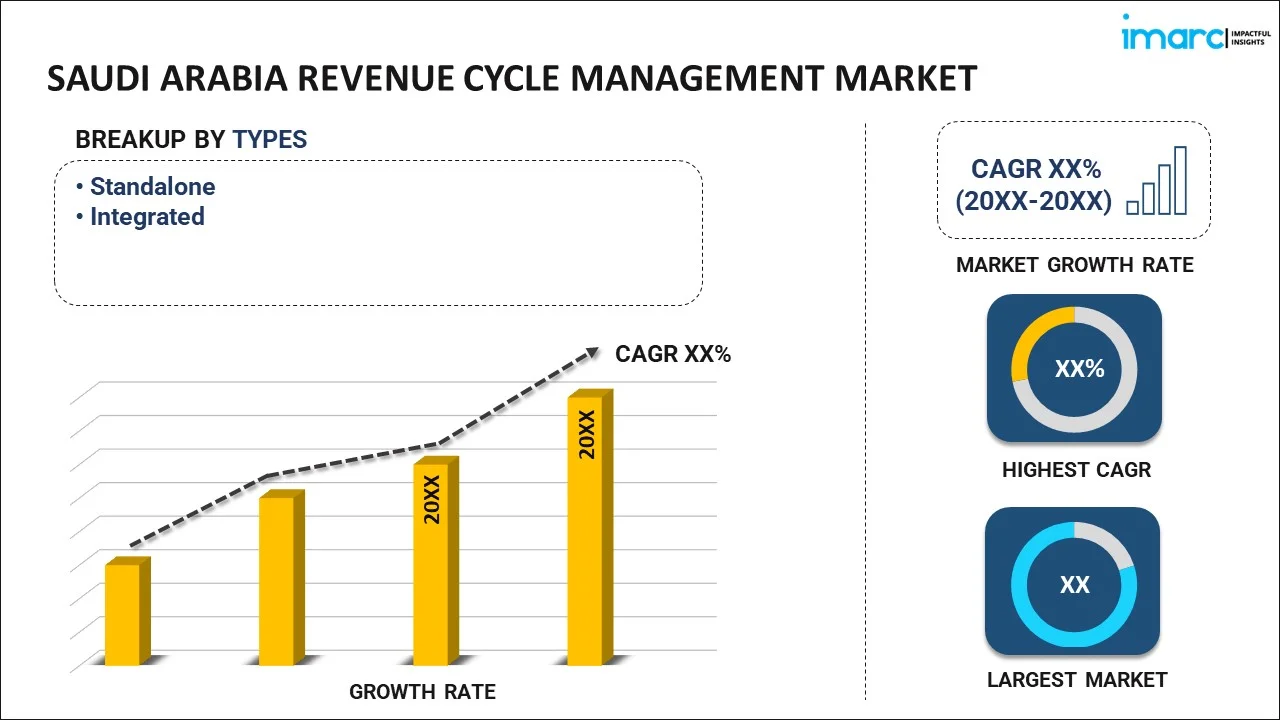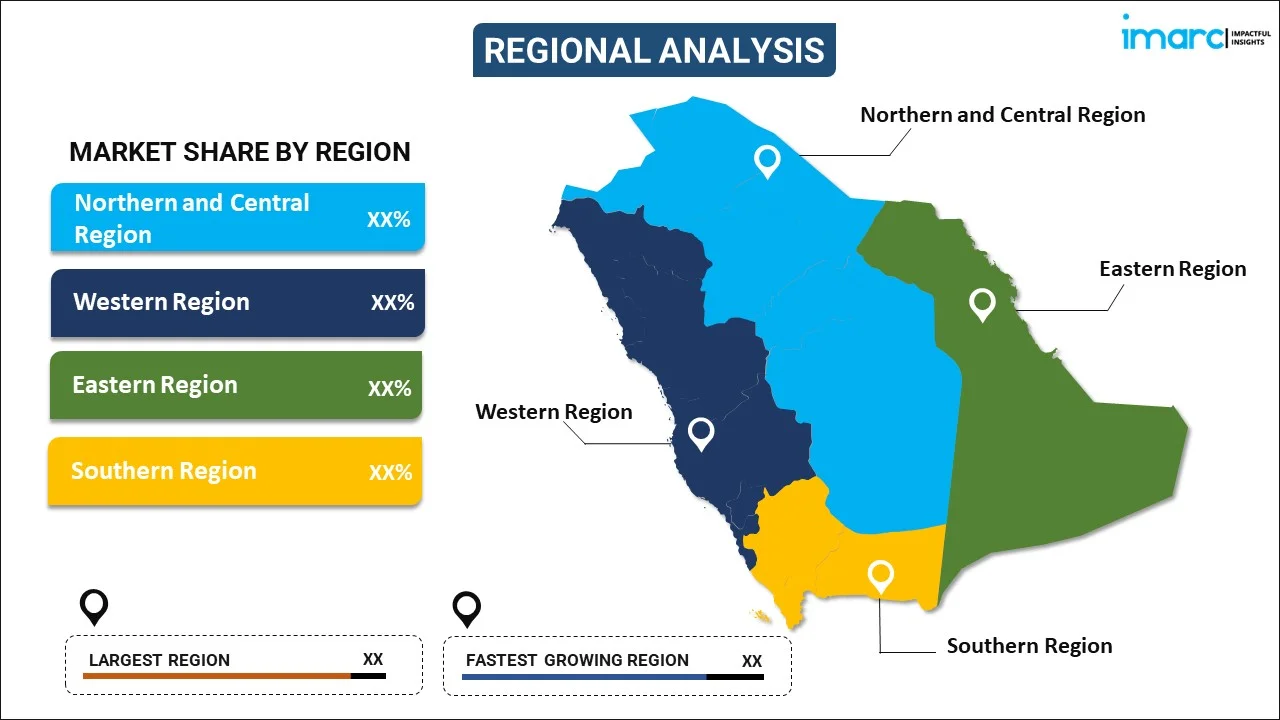
Saudi Arabia Revenue Cycle Management Market Report by Type (Standalone, Integrated), Component (Software, Services), Deployment (Web-based, Cloud-based, On-premises), End User (Hospitals, Physicians, Diagnostic and Ambulatory Care Centers), and Region 2025-2033
Market Overview:
Saudi Arabia revenue cycle management market size reached USD 1,382.0 Million in 2024. Looking forward, IMARC Group expects the market to reach USD 3,762.1 Million by 2033, exhibiting a growth rate (CAGR) of 11.77% during 2025-2033. The increasing advances in technology, including the use of artificial intelligence, machine learning, and data analytics, which have improved the efficiency and accuracy of revenue cycle management processes, are driving the market.
|
Report Attribute
|
Key Statistics
|
|---|---|
|
Base Year
|
2024
|
|
Forecast Years
|
2025-2033
|
|
Historical Years
|
2019-2024
|
|
Market Size in 2024
|
USD 1,382.0 Million |
|
Market Forecast in 2033
|
USD 3,762.1 Million |
| Market Growth Rate 2025-2033 | 11.77% |
Revenue cycle management (RCM) is a systematic approach that healthcare organizations use to track the entire lifespan of a patient's interaction, from appointment scheduling to final payment collection. It involves managing administrative and clinical functions related to billing, claims processing, and revenue generation. RCM aims to optimize financial performance by ensuring accurate and timely reimbursement for services provided. Key components include patient registration, insurance verification, charge capture, coding, claims submission, and payment posting. Effective RCM reduces billing errors, accelerates cash flow, and enhances overall operational efficiency. Automation and technology play crucial roles in streamlining processes, minimizing human errors, and improving the overall financial health of healthcare institutions. By focusing on the entire revenue cycle, organizations can enhance patient satisfaction, compliance, and financial sustainability.
Saudi Arabia Revenue Cycle Management Market Trends:
The revenue cycle management market in Saudi Arabia is witnessing robust growth fueled by several key drivers. Firstly, the increasing adoption of electronic health records (EHR) across healthcare organizations is a significant catalyst. As healthcare providers transition to digital platforms, the demand for streamlined RCM solutions rises, driving market expansion. Additionally, the growing emphasis on cost containment in the healthcare sector propels the adoption of efficient RCM systems. Consequently, providers seek solutions that optimize billing processes, reduce denials, and enhance overall revenue capture. Moreover, the evolving regulatory landscape contributes to the momentum in the RCM market. Healthcare providers are compelled to comply with changing regulations, such as value-based care models, necessitating advanced RCM tools to navigate complex billing requirements. Furthermore, the escalating healthcare expenditure and the need for efficient financial management propel the demand for RCM solutions, as providers aim to maximize revenue and minimize operational costs. Furthermore, the increasing trend of outsourcing RCM services is a noteworthy driver. Healthcare organizations are recognizing the benefits of partnering with specialized RCM vendors to leverage their expertise, technology, and resources, thereby driving market growth. In conclusion, a convergence of factors, including digitalization, regulatory dynamics, financial imperatives, and outsourcing trends, collectively propels the RCM market forward in Saudi Arabia.
Saudi Arabia Revenue Cycle Management Market Segmentation:
IMARC Group provides an analysis of the key trends in each segment of the market, along with forecasts at the country level for 2025-2033. Our report has categorized the market based on type, component, deployment, and end user.
Type Insights:

- Standalone
- Integrated
The report has provided a detailed breakup and analysis of the market based on the type. This includes standalone and integrated.
Component Insights:
- Software
- Services
A detailed breakup and analysis of the market based on the component have also been provided in the report. This includes software and services.
Deployment Insights:
- Web-based
- Cloud-based
- On-premises
The report has provided a detailed breakup and analysis of the market based on the deployment. This includes web-based, cloud-based, and on-premises.
End User Insights:
- Hospitals
- Physicians
- Diagnostic and Ambulatory Care Centers
A detailed breakup and analysis of the market based on the end user have also been provided in the report. This includes hospitals, physicians, and diagnostic and ambulatory care centers.
Regional Insights:

- Northern and Central Region
- Western Region
- Eastern Region
- Southern Region
The report has also provided a comprehensive analysis of all the major regional markets, which include Northern and Central Region, Western Region, Eastern Region, and Southern Region.
Competitive Landscape:
The market research report has also provided a comprehensive analysis of the competitive landscape. Competitive analysis such as market structure, key player positioning, top winning strategies, competitive dashboard, and company evaluation quadrant has been covered in the report. Also, detailed profiles of all major companies have been provided.
Saudi Arabia Revenue Cycle Management Market Report Coverage:
| Report Features | Details |
|---|---|
| Base Year of the Analysis | 2024 |
| Historical Period | 2019-2024 |
| Forecast Period | 2025-2033 |
| Units | Million USD |
| Scope of the Report | Exploration of Historical Trends and Market Outlook, Industry Catalysts and Challenges, Segment-Wise Historical and Future Market Assessment:
|
| Types Covered | Standalone, Integrated |
| Components Covered | Software, Services |
| Deployments Covered | Web-based, Cloud-based, On-premises |
| End Users Covered | Hospitals, Physicians, Diagnostic and Ambulatory Care Centers |
| Regions Covered | Northern and Central Region, Western Region, Eastern Region, Southern Region |
| Customization Scope | 10% Free Customization |
| Post-Sale Analyst Support | 10-12 Weeks |
| Delivery Format | PDF and Excel through Email (We can also provide the editable version of the report in PPT/Word format on special request) |
Key Questions Answered in This Report:
- How has the Saudi Arabia revenue cycle management market performed so far and how will it perform in the coming years?
- What has been the impact of COVID-19 on the Saudi Arabia revenue cycle management market?
- What is the breakup of the Saudi Arabia revenue cycle management market on the basis of type?
- What is the breakup of the Saudi Arabia revenue cycle management market on the basis of component?
- What is the breakup of the Saudi Arabia revenue cycle management market on the basis of deployment?
- What is the breakup of the Saudi Arabia revenue cycle management market on the basis of end user?
- What are the various stages in the value chain of the Saudi Arabia revenue cycle management market?
- What are the key driving factors and challenges in the Saudi Arabia revenue cycle management?
- What is the structure of the Saudi Arabia revenue cycle management market and who are the key players?
- What is the degree of competition in the Saudi Arabia revenue cycle management market?
Key Benefits for Stakeholders:
- IMARC’s industry report offers a comprehensive quantitative analysis of various market segments, historical and current market trends, market forecasts, and dynamics of the Saudi Arabia revenue cycle management market from 2019-2033.
- The research report provides the latest information on the market drivers, challenges, and opportunities in the Saudi Arabia revenue cycle management market.
- Porter's five forces analysis assist stakeholders in assessing the impact of new entrants, competitive rivalry, supplier power, buyer power, and the threat of substitution. It helps stakeholders to analyze the level of competition within the Saudi Arabia revenue cycle management industry and its attractiveness.
- Competitive landscape allows stakeholders to understand their competitive environment and provides an insight into the current positions of key players in the market.
Need more help?
- Speak to our experienced analysts for insights on the current market scenarios.
- Include additional segments and countries to customize the report as per your requirement.
- Gain an unparalleled competitive advantage in your domain by understanding how to utilize the report and positively impacting your operations and revenue.
- For further assistance, please connect with our analysts.
 Inquire Before Buying
Inquire Before Buying
 Speak to an Analyst
Speak to an Analyst
 Request Brochure
Request Brochure
 Request Customization
Request Customization




.webp)




.webp)












